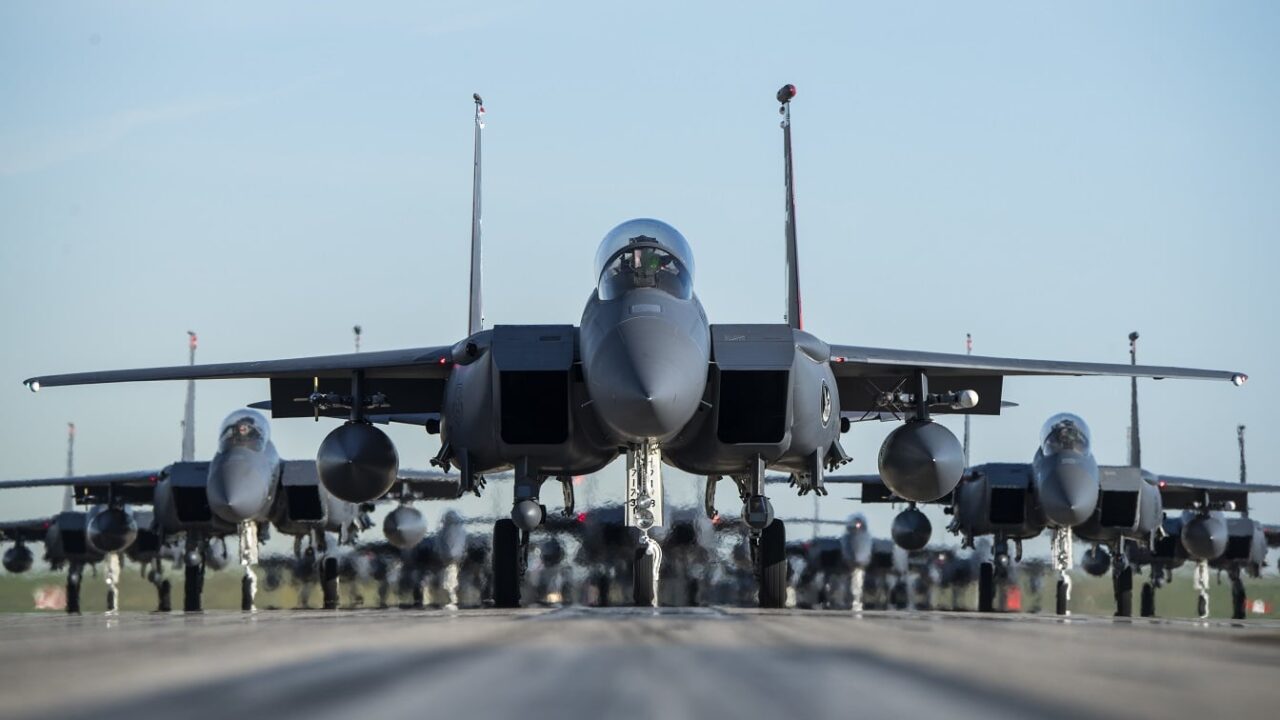The United States Air Force’s fleet of F-15 Eagles will begin saying “sayonara” to Okinawa in the coming weeks, as the service plans to replace the aging – but still combat-proven – warbird with more modern aircraft. The move will reportedly involve half of the roughly 100 Air Force fighters currently deployed to Japan, and some critics are warning that it could result in possible gaps that could weaken the ability to deter China.
Two squadrons of the F-15 Eagle that have been permanently based at Kadena Air Base, Okinawa will eventually be retired as the U.S. Department of Defense (DoD) begins its “phased withdrawal” of F-15C/D Strike Eagles. Those aircraft could be replaced, at least initially, by F-22 squadrons currently based in Alaska. The first Lockheed Martin F-22 Raptors could begin being deployed to Kadena in early November.

F-22 Raptor. Image Credit: Creative Commons.
“The message to China is the U.S. is not serious about reversing the decline in its military forces,” David Deptula, former vice commander of Pacific Air Forces and a retired F-15 pilot, told the Financial Times newspaper. “This will encourage the Chinese to take more dramatic action.”
Experts have also warned that the rotation could put stress on the force and that there aren’t enough of the advanced F-22 Raptors in service to fill all of its roles, including deployment to Europe to deter Russia, and to National Guard and Reserve units in the United States.
Eagles Leaving the Nest at Kadena
Kadena Air Base on Okinawa is currently home to 48 F-15C/Ds of the 18th Wing’s 44th Fighter Squadron “Vampires” and the 67th Fighter Squadron “Fighting Cocks.” The planes first arrived at the base in 1979.
They have served as a lynchpin of U.S. defenses in the region. However, the U.S. Air Force also has F-16 Fighting Falcons at Misawa Air Base in northeastern Honshu, the largest of Japan’s four main islands.
Though not a stealth platform, the F-15 is a proven air superiority aircraft that can operate as a fighter and as a precision bomber. Considered among the most successful modern fighters in service today, the F-15 Eagle has more than 100 victories to its credit with not a single loss in aerial combat.
With a top speed in excess of Mach 2.5 (more than 1,600 mph or 2,575 kph), the F-15 Eagle was the first U.S. fighter with enough thrust to accelerate vertically. It could be armed with a large complement of missiles but was also equipped with an internal 20 mm Gatling gun. An extremely maneuverable tactical fighter that was equipped with advanced avionics for the era; the Eagle could quickly achieve air superiority – outperforming and outfighting any enemy aircraft.
However, the issue is the age of the F-15s now regularly flying out of Kadena. With an average age of nearly 38 years, the aircraft are older than the pilots flying those warbirds. Though the Air Force has upgraded the craft, the airframes can’t be pushed to the limit anymore, while many of the electronics are so old that the parts are no longer produced. The Eagles are truly flying on borrowed time – so it makes sense to replace them.
The unfortunate part is that the U.S. Air Force barely has the aircraft ready to replace them, even temporarily. The service will need to come up with a plan, quickly, and whether it is more F-15EXs – Boeing’s greatly improved Eagle – or restarting the F-22 program, something needs to be done. This should be the Air Force’s wake-up moment.
F-15 Eagle Photos

Image: USAF

A Boeing (McDonnell Douglas) F-15E “Strike Eagle” assigned to the 492nd Fighter Squadron performs a high-speed pass over RAF Lakenheath, England, April 10, 2019. The 492nd conducts routine training daily to ensure RAF Lakenheath brings unique air combat capabilities to the fight when called upon by U.S. Air Forces in Europe-Air Forces Africa.
A Senior Editor for 1945, Peter Suciu is a Michigan-based writer. He has contributed to more than four dozen magazines, newspapers, and websites with over 3,000 published pieces over a twenty-year career in journalism. He regularly writes about military hardware, firearms history, cybersecurity, and international affairs. Peter is also a Contributing Writer for Forbes. You can follow him on Twitter: @PeterSuciu.

